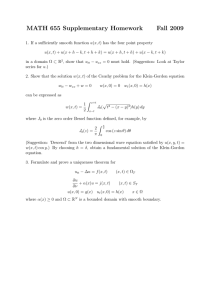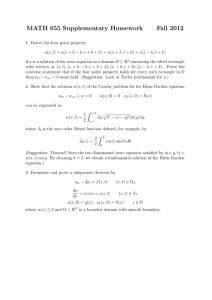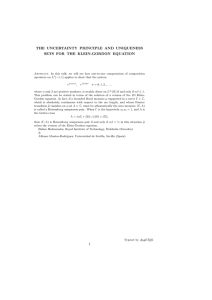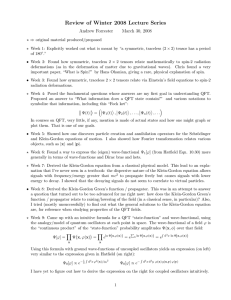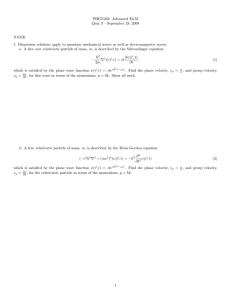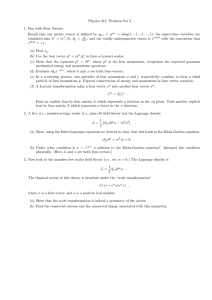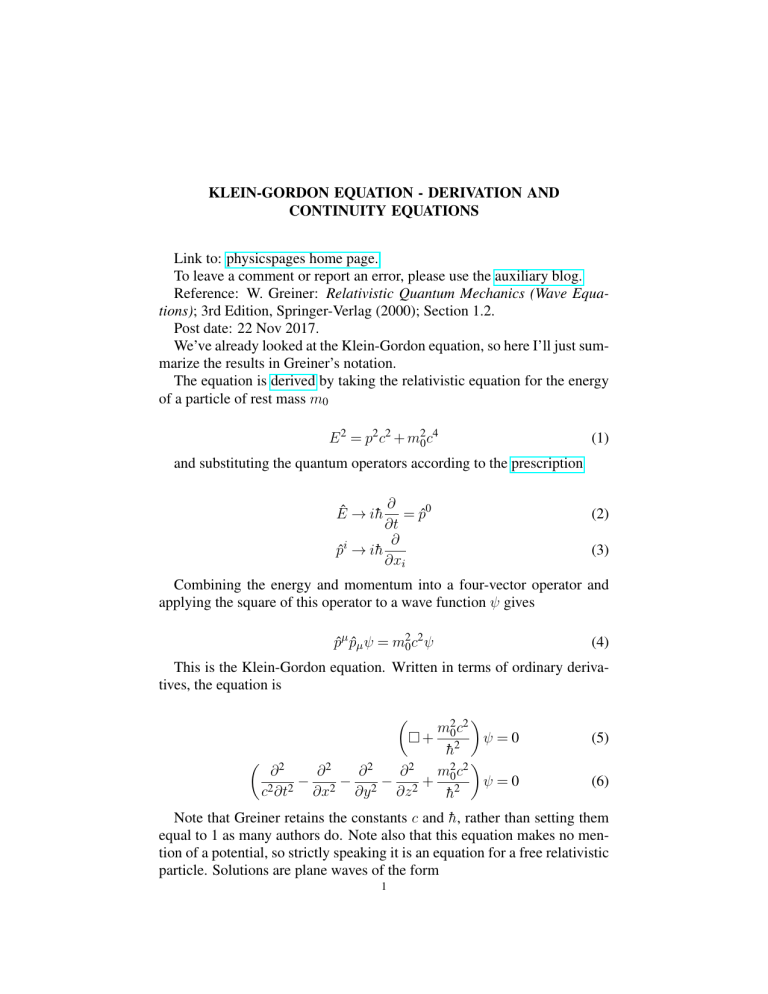
KLEIN-GORDON EQUATION - DERIVATION AND
CONTINUITY EQUATIONS
Link to: physicspages home page.
To leave a comment or report an error, please use the auxiliary blog.
Reference: W. Greiner: Relativistic Quantum Mechanics (Wave Equations); 3rd Edition, Springer-Verlag (2000); Section 1.2.
Post date: 22 Nov 2017.
We’ve already looked at the Klein-Gordon equation, so here I’ll just summarize the results in Greiner’s notation.
The equation is derived by taking the relativistic equation for the energy
of a particle of rest mass m0
E 2 = p2 c2 + m20 c4
(1)
and substituting the quantum operators according to the prescription
∂
= p̂0
∂t
∂
p̂i → ih̄
∂xi
Ê → ih̄
(2)
(3)
Combining the energy and momentum into a four-vector operator and
applying the square of this operator to a wave function ψ gives
p̂µ p̂µ ψ = m20 c2 ψ
(4)
This is the Klein-Gordon equation. Written in terms of ordinary derivatives, the equation is
m20 c2
+ 2
ψ=0
h̄
2
m20 c2
∂
∂2
∂2
∂2
−
−
−
+ 2
ψ=0
c2 ∂t2 ∂x2 ∂y 2 ∂z 2
h̄
(5)
(6)
Note that Greiner retains the constants c and h̄, rather than setting them
equal to 1 as many authors do. Note also that this equation makes no mention of a potential, so strictly speaking it is an equation for a free relativistic
particle. Solutions are plane waves of the form
1
KLEIN-GORDON EQUATION - DERIVATION AND CONTINUITY EQUATIONS
i
µ
ψ = exp − pµ x
h̄
i
0
= exp − p0 x − p · x
h̄
i
= exp
(p · x − Et)
h̄
2
(7)
(8)
(9)
where we’ve used the explicit form of the four-momentum and spacetime
xµ = g µν xν = {ct, x, y, z}
E
, −px , −py − pz
pν =
c
(10)
(11)
Substituting this solution back into 6 leads back to the energy equation
1, which gives E 2 and not just E itself. As a result, the Klein-Gordon
equation predicts that a given plane wave solution can have either a positive
or negative energy:
q
E = ± p2 c2 + m20 c4
(12)
In an earlier post, we derived the continuity equation for the Klein-Gordon
equation which is
∂ρ
+∇·j = 0
∂t
(13)
In Greiner’s notation
ih̄
∂ψ ∗
∗ ∂ψ
ρ=
ψ
−ψ
2m0 c2
∂t
∂t
ih̄
j=−
(ψ ∗ ∇ψ − ψ∇ψ ∗ )
2m0
(14)
(15)
It seems natural to consider j as a probability current and ρ to be a probability density analogous to the quantity |ψ|2 where ψ here is the wave function that solves the Schrödinger equation in non-relativistic theory. However, although j in 15 has exactly the same form as the probability current
in the Schrödinger equation, the density ρ does not, and in fact is not always
positive, since ψ and its derivative could in practice take on values that make
ρ negative. Thus we can’t interpret the continuity equation 13 as the conservation of probability. This problem, along with the existence of negative
KLEIN-GORDON EQUATION - DERIVATION AND CONTINUITY EQUATIONS
3
energies, were taken to be major problems with the Klein-Gordon equation
which led to it being disregarded initially as a valid relativistic equation.
P INGBACKS
Pingback: Klein-gordon equation - nonrelativistic limit
Pingback: Klein-gordon equation - charged particles
Pingback: Klein-Gordon equation in Schrödinger form
Pingback: Klein-Gordon equation - interaction with electromagnetic field
Pingback: Neutral Klein-Gordon field - Lagrangian and hamiltonian
Pingback: Real scalar field - fourier decomposition
